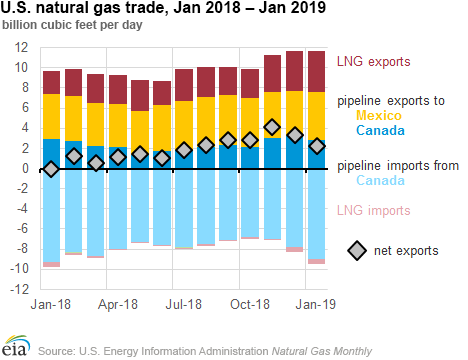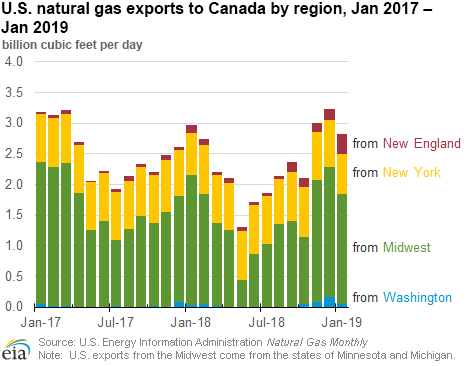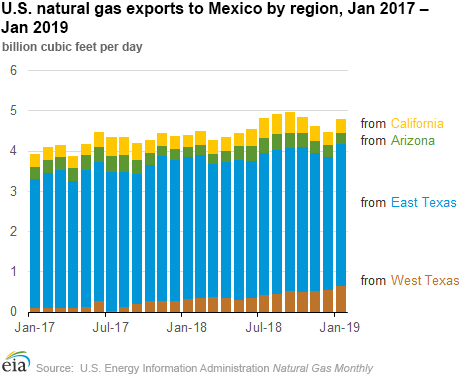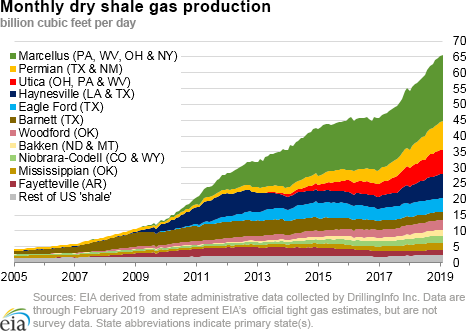In the News:
United States has been a net exporter of natural gas for more than 12 consecutive months
According to EIA’s most recent publication of the Natural Gas Monthly, U.S. net natural gas exports in January 2019 totaled 2.3 billion cubic feet per day (Bcf/d), marking 12 consecutive months where U.S. natural gas exports exceeded U.S. imports. Preliminary data from PointLogic Energy indicate that this trend continued through February and March 2019. Exports from the United States via pipeline to both Canada and Mexico, as well as U.S. exports of liquefied natural gas (LNG), were all at or near record highs as of January 2019.
U.S. LNG exports totaled 4.1 Bcf/d in January 2019, marking the third consecutive month where a new record high was reached. The volume of U.S. LNG exports rose steadily during 2018 as three new liquefaction units, called trains, totaling 1.9 Bcf/d capacity, entered service:
- A single train at the Cove Point terminal in March 2018
- Train 5 at the Sabine Pass terminal in November 2018
- Train 1 at the Corpus Christi terminal in December 2018
LNG export volumes are expected to continue to rise in 2019 as an additional 4 Bcf/d of liquefaction capacity is brought online by the end of the year.
U.S. exports via pipeline to Canada, which had been lower in recent years, have risen since November 2018, when both the second phase of the Rover pipeline and the NEXUS pipeline entered service. These two projects bring low-cost natural gas from the Marcellus and Utica plays to the Dawn Hub in Ontario, Canada. U.S. exports to Canada in January 2019 were 2.8 Bcf/d, down from 3.2 Bcf/d in December 2018―the highest volume observed since December 2012.
U.S. pipeline exports of natural gas to Mexico in January 2019 were 4.8 Bcf/d, a year-on-year increase of almost 0.4 Bcf/d. Much of the year-on-year growth is attributed to increased U.S. exports out of the Permian Basin in western Texas as new pipelines and natural gas-fired power plant projects within Mexico entered service. In addition, several existing pipelines in southeastern Texas completed expansions during the past 12 months, increasing cross-border capacity.
EIA’s Short Term Energy Outlook forecasts U.S. net natural gas exports to average 5.6 Bcf/d in 2019 and grow by another 50% in 2020, led mostly by the growth in LNG exports as three new LNG facilities will be commissioned in the next two years.
Overview:
(For the week ending Wednesday, March 3, 2019)
- Natural gas spot price movements were mixed this report week (Wednesday, March 27 to Wednesday, April 3). Henry Hub spot prices rose from $2.66 per million British thermal units (MMBtu) last Wednesday to $2.67/MMBtu yesterday.
- At the Nymex, the April 2019 contract expired last Wednesday at $2.713/MMBtu. The May 2019 contract decreased to $2.677/MMBtu, down 4¢/MMBtu from last Wednesday to yesterday. The price of the 12-month strip averaging May 2019 through April 2020 futures contracts declined 4¢/MMBtu to $2.846/MMBtu.
- Net injections to working gas totaled 23 billion cubic feet (Bcf) for the week ending March 29. Working natural gas stocks are 1,130 Bcf, which is 17% lower than the year-ago level and 31% lower than the five-year (2014–18) average for this week.
- According to Baker Hughes, for the week ending Tuesday, March 26, the natural gas rig count decreased by 2 to 190. The number of oil-directed rigs fell by 8 to 816. The total rig count decreased by 10, and it now stands at 1,006.
Prices/Supply/Demand:
Prices movements mixed. This report week (Wednesday, March 27 to Wednesday, April 3), price movements varied across the country. Henry Hub spot prices rose 1¢ from $2.66/MMBtu last Wednesday to $2.67/MMBtu yesterday. At the Chicago Citygate, prices increased 6¢ from $2.52/MMBtu last Wednesday to $2.58/MMBtu yesterday. Prices at PG&E Citygate in Northern California rose 8¢, up from $3.63/MMBtu last Wednesday to $3.71/MMBtu yesterday. Prices at SoCal Citygate decreased 18¢ from $4.09/MMBtu last Wednesday to $3.91/MMBtu yesterday, with a low of $3.28/MMBtu on Friday.
Northeast prices respond to weekend cold. At the Algonquin Citygate, which serves Boston-area consumers, prices went down 3¢ from $2.73/MMBtu last Wednesday to $2.70/MMBtu yesterday. Despite the small week-on-week change, Algonquin experienced intra-week price volatility. Prices went from a weekly low of $2.57/MMBtu on Thursday to a weekly high of $3.12/MMBtu on Friday as a result of a cold temperatures expected over the weekend. At the Transcontinental Pipeline Zone 6 trading point for New York City, prices increased 11¢ from $2.50/MMBtu last Wednesday to $2.61/MMBtu yesterday. Transco Zone 6 had a weekly low of $2.33/MMBtu on Thursday and a weekly high of $2.77/MMBtu on Monday.
Tennessee Zone 4 Marcellus spot prices increased 9¢ from $2.36/MMBtu last Wednesday to $2.45/MMBtu yesterday, with a low of $2.14/MMBtu on Thursday. Prices at Dominion South in southwest Pennsylvania rose 5¢ from $2.41/MMBtu last Wednesday to $2.46/MMBtu yesterday.
Waha prices fall further into negative territory amid ongoing pipeline maintenance and constraints. Prices at the Waha Hub in West Texas, which is located near Permian Basin production activities, averaged -$0.75/MMBtu last Wednesday, $3.41/MMBtu lower than Henry Hub prices. Yesterday, prices at the Waha Hub dropped even lower, averaging -$5.75/MMBtu, or $8.42/MMBtu lower than Henry Hub prices.
Daily spot prices at Waha remained negative throughout the report week, with Wednesday’s price representing an all-time record low for anywhere in the United States. Natural gas prices in the region have been depressed since 2017 as pipeline takeaway capacity has struggled to keep up with increasing production of associated-dissolved natural gas. Recent reductions in capacity have exacerbated this already constrained takeaway capacity, and spring temperatures are expected to reduce local demand of natural gas. After the El Paso Natural Gas Company declared a force majeure at the Florida and Lordsburg compressor stations in southwest New Mexico on March 18 as a result of equipment failures, capacity on the El Paso Pipeline flowing out of the Permian was reduced by almost 0.2 Bcf/d. The Florida compressor station returned to full service on March 30, and the Lordsburg compressor station returned to full service on April 3. However, a number of other planned and unplanned maintenance events on several pipelines are limiting flows out of the Permian.
Supply remains flat. According to data from PointLogic Energy, the average total supply of natural gas remained the same as in the previous report week, averaging 94.6 Bcf/d. Dry natural gas production remained constant week over week. Average net imports from Canada increased by 2% from last week, but were 16% lower than last year at this time.
Demand falls as temperatures moderate. Total U.S. consumption of natural gas fell by 4% compared with the previous report week, according to data from PointLogic Energy. Natural gas consumed for power generation climbed by 2% week over week. Industrial sector consumption decreased by 1% week over week. In the residential and commercial sectors, consumption declined by 12% as overall warmer temperatures across the country led to lower heating demand. Natural gas exports to Mexico increased 1%.
U.S. LNG exports increase week over week. Seven LNG vessels (five from Sabine Pass and two from Corpus Christi) with a combined LNG-carrying capacity of 25.3 Bcf departed the United States from March 28 to April 3, according to shipping data compiled by Bloomberg. Data for Cove Point LNG exports were unavailable.
Storage:
Net injections into storage totaled 23 Bcf for the week ending March 29, compared with the five-year (2014–18) average net withdrawals of 23 Bcf and last year's net withdrawals of 34 Bcf during the same week. Working gas stocks totaled 1,130 Bcf, which is 505 Bcf lower than the five-year average and 228 Bcf lower than last year at this time.
According to The Desk survey of natural gas analysts, estimates of the weekly net change from working natural gas stocks ranged from net withdrawals of 2 Bcf to net injections of 27 Bcf, with a median estimate of net injections of 14 Bcf.
More storage data and analysis can be found on the Natural Gas Storage Dashboard and the Weekly Natural Gas Storage Report.
See also:
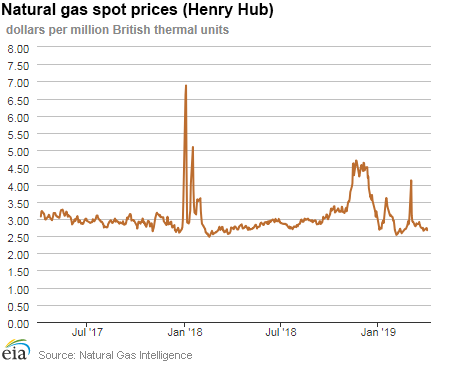
| Spot Prices ($/MMBtu) | Thu, 28-Mar |
Fri, 29-Mar |
Mon, 01-Apr |
Tue, 02-Apr |
Wed, 03-Apr |
|---|---|---|---|---|---|
| Henry Hub |
2.67 |
2.69 |
2.72 |
2.74 |
2.67 |
| New York |
2.33 |
2.70 |
2.77 |
2.59 |
2.61 |
| Chicago |
2.56 |
2.59 |
2.62 |
2.59 |
2.58 |
| Cal. Comp. Avg.* |
2.68 |
2.77 |
2.81 |
2.93 |
2.88 |
| Futures ($/MMBtu) | |||||
| May contract | 2.712 |
2.662 |
2.708 |
2.684 |
2.677 |
| June contract |
2.761 |
2.713 |
2.749 |
2.722 |
2.715 |
| *Avg. of NGI's reported prices for: Malin, PG&E Citygate, and Southern California Border Avg. | |||||
| Sources: Natural Gas Intelligence and CME Group as compiled by Bloomberg, L.P. | |||||
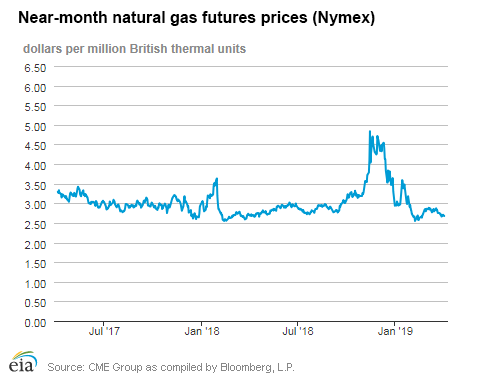
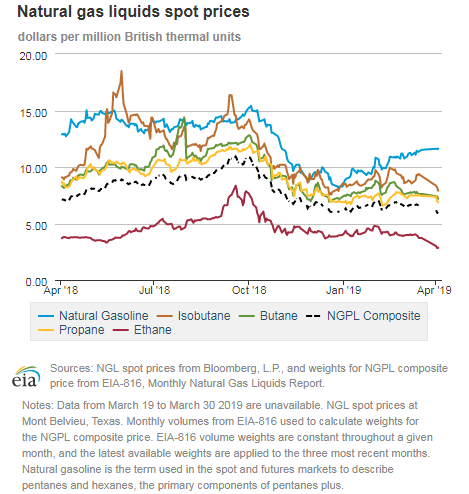
| U.S. natural gas supply - Gas Week: (3/28/19 - 4/3/19) | |||
|---|---|---|---|
Average daily values (Bcf/d): |
|||
this week |
last week |
last year |
|
| Marketed production | 100.4 |
100.0 |
90.3 |
| Dry production | 89.7 |
89.4 |
80.6 |
| Net Canada imports | 4.8 |
4.7 |
5.8 |
| LNG pipeline deliveries | 0.1 |
0.1 |
0.4 |
| Total supply | 94.6 |
94.2 |
86.7 |
|
Source: OPIS PointLogic Energy, an IHS Company | |||
| U.S. natural gas consumption - Gas Week: (3/28/19 - 4/3/19) | |||
|---|---|---|---|
Average daily values (Bcf/d): |
|||
this week |
last week |
last year |
|
| U.S. consumption | 69.5 |
72.7 |
70.7 |
| Power | 21.9 |
21.4 |
22.9 |
| Industrial | 21.4 |
21.6 |
21.5 |
| Residential/commercial | 26.2 |
29.7 |
26.4 |
| Mexico exports | 4.6 |
4.6 |
3.6 |
| Pipeline fuel use/losses | 6.3 |
6.3 |
5.8 |
| LNG pipeline receipts | 4.1 |
4.1 |
3.7 |
| Total demand | 84.4 |
87.7 |
83.8 |
|
Source: OPIS PointLogic Energy, an IHS Company | |||
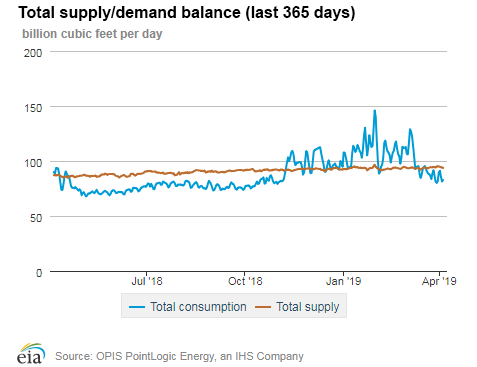
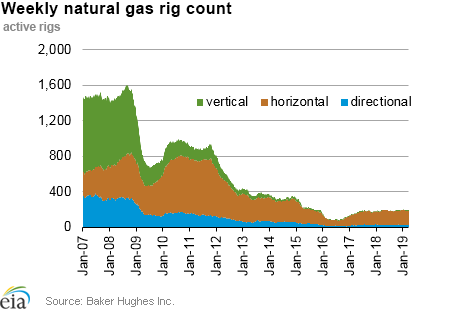
| Rigs | |||
|---|---|---|---|
Tue, March 26, 2019 |
Change from |
||
last week |
last year |
||
| Oil rigs | 816 |
-1.0% |
2.4% |
| Natural gas rigs | 190 |
-1.0% |
-2.1% |
| Note: Excludes any miscellaneous rigs | |||
| Rig numbers by type | |||
|---|---|---|---|
Tue, March 26, 2019 |
Change from |
||
last week |
last year |
||
| Vertical | 51 |
-3.8% |
-19.0% |
| Horizontal | 891 |
-1.0% |
2.4% |
| Directional | 64 |
1.6% |
6.7% |
| Source: Baker Hughes Inc. | |||
| Working gas in underground storage | ||||
|---|---|---|---|---|
Stocks billion cubic feet (Bcf) |
||||
| Region | 2019-03-29 |
2019-03-22 |
change |
|
| East | 210 |
225 |
-15 |
|
| Midwest | 241 |
248 |
-7 |
|
| Mountain | 64 |
62 |
2 |
|
| Pacific | 113 |
104 |
9 |
|
| South Central | 502 |
467 |
35 |
|
| Total | 1,130 |
1,107 |
23 |
|
| Source: Form EIA-912, Weekly Underground Natural Gas Storage Report | ||||
| Working gas in underground storage | |||||
|---|---|---|---|---|---|
Historical comparisons |
|||||
Year ago (3/29/18) |
5-year average (2014-2018) |
||||
| Region | Stocks (Bcf) |
% change |
Stocks (Bcf) |
% change |
|
| East | 231 |
-9.1 |
271 |
-22.5 |
|
| Midwest | 269 |
-10.4 |
339 |
-28.9 |
|
| Mountain | 87 |
-26.4 |
115 |
-44.3 |
|
| Pacific | 166 |
-31.9 |
203 |
-44.3 |
|
| South Central | 606 |
-17.2 |
705 |
-28.8 |
|
| Total | 1,358 |
-16.8 |
1,635 |
-30.9 |
|
| Source: Form EIA-912, Weekly Underground Natural Gas Storage Report | |||||
| Temperature – heating & cooling degree days (week ending Mar 28) | ||||||||
|---|---|---|---|---|---|---|---|---|
HDD deviation from: |
CDD deviation from: |
|||||||
| Region | HDD Current |
normal |
last year |
CDD Current |
normal |
last year |
||
| New England | 190 |
10 |
3 |
0 |
0 |
0 |
||
| Middle Atlantic | 178 |
13 |
-14 |
0 |
0 |
0 |
||
| E N Central | 171 |
-1 |
-6 |
0 |
0 |
0 |
||
| W N Central | 143 |
-27 |
-34 |
0 |
-1 |
0 |
||
| South Atlantic | 104 |
12 |
-21 |
9 |
-3 |
-1 |
||
| E S Central | 90 |
4 |
-6 |
0 |
-5 |
0 |
||
| W S Central | 35 |
-14 |
2 |
17 |
4 |
-3 |
||
| Mountain | 116 |
-28 |
-39 |
3 |
0 |
3 |
||
| Pacific | 87 |
4 |
-23 |
0 |
-1 |
0 |
||
| United States | 128 |
-2 |
-15 |
4 |
-1 |
0 |
||
|
Note: HDD = heating degree day; CDD = cooling degree day Source: National Oceanic and Atmospheric Administration | ||||||||
Average temperature (°F)
7-day mean ending Mar 28, 2019
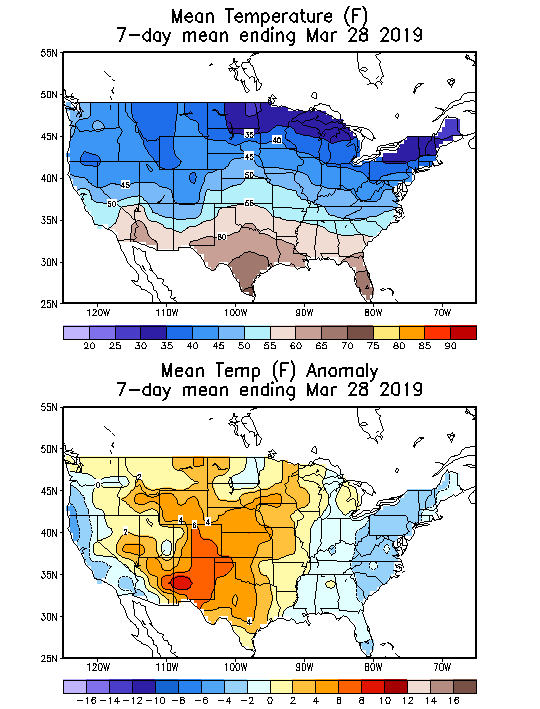
Source: National Oceanic and Atmospheric Administration
Deviation between average and normal (°F)
7-day mean ending Mar 28, 2019

Source: National Oceanic and Atmospheric Administration

